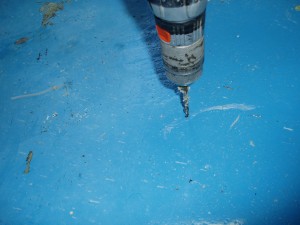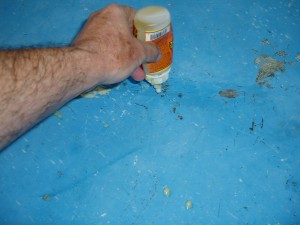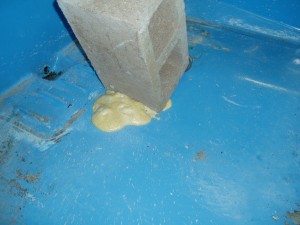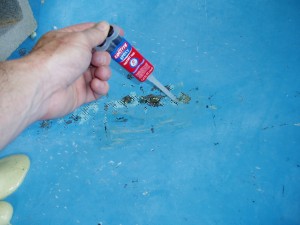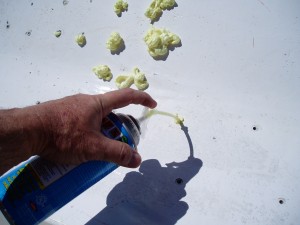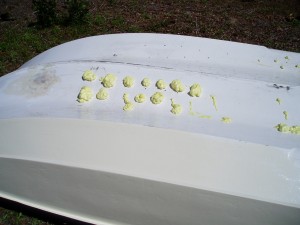Gorilla Glue and Foam Sealer both expand when introduced into a void. Gorilla Glue is especially water friendly and works in wet areas just fine. In fact the more water the more foam it will create. Gorilla glue dries harder and does not absorb water very easily. Foam sealer is a little softer and will absorb water more easily. In areas where water may get in again and where I need a very stable base beneath the fiberglass I use Gorilla Glue. In areas that tend to stay dry and do not need as much support I use the foam sealer.
To fix soft spots with either Gorilla Glue or Foam Sealer you can follow these simple steps.
First, locate the soft spot and find its outer edges. You can trace it out with a pencil if you wish. If you have multiple spots just trace them all out at one time.
Second, drill holes using a drill no larger than a pencil. The bit needs to be just large enough for the spout of the Gorilla Glue or Sealer nozzle to fit into. The holes need to be all the way around the soft spot. Say one every few inches. Also, put several in the center of the spot. The extra holes will give the foam a place to escape. One hole may not be sufficient. I use a very short drill bit so I do not go through the other side of the boat.
Third, squeeze in the Gorilla Glue or Sealer. Fill each hole. If you fill one hole and the glue comes out other holes that is good. You will need to force the glue into the void.
Fourth, place a weight on the area. This will keep the glue from bowing the surface. I have done areas and not used a weight with no problems but it is better to be safe. I use a concrete block and tip it on its edge. This way it is easier to remove. If you lay it flat you will glue it to the boat and will not be able to easily get it off.
Fifth, let the glue dry, expand, foam, etc.. It will come out of the holes quite a bit if the area was wet. I normally wait a few hours or overnight.
Sixth, remove the weight and scrape the excess Glue off with a putty knife or any flat blade. The grind away any excess until you are back down to the bare fiberglass and holes.
Seventh, take a drill bit or steel rod and put it into the hole and make a void right at the surface down just a fraction. Do this for all the holes. Then take a disc sander and hit each hole so it becomes a little divit. Just slightly. The idea with this step is to give the epoxy you are going to use a place to bond both inside and outside the holes.
Eighth, mix epoxy or use the epoxy in the syringe and force it into all the holes. Fill them all the way to the top. Then let the epoxy set up until it is completely hard.
Ninth, once the epoxy is hard, grind the area down smooth. If the area is in a place that you feel needs more reinforcement then sand the area, apply some epoxy and fiberglass cloth and let it set up.
After you have completed these steps you can paint the area.
Foam goes in one hole and will normally come out multiple holes. Use the type of foam that is designed NOT to bow or distort. It is normally in the blue can. The other type which is normally in a red can and called Great Stuff may bulge the hull. I have found the blue can type to be safer. Also, I have had no problems with the Gorilla glue bowing the hull. After I filled the holes with foam I reamed out the hole and forced in epoxy. Then I sanded the area and applied a layer of west epoxy with the collodial silica thickener in it. If there were cracks or weak areas I added some fiberglass cloth to the repair. Then I painted the area with polyurethane topsides paint.
